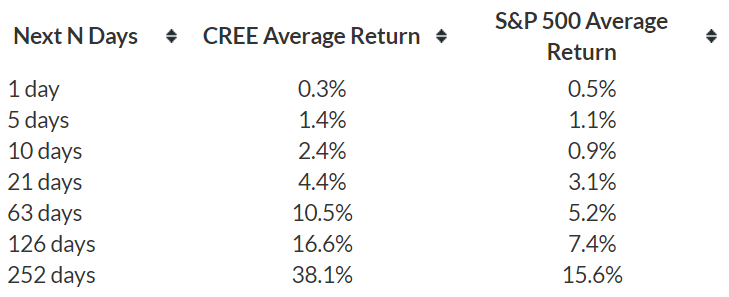9% Drop In Cree Stock A Buying Opportunity?
The stock price of Cree (NASDAQ:CREE) reached its 52-week high of $130 back in February 2021, and has since dropped more than 30% from that level. Cree, a power and radio frequency (RF) semiconductor manufacturer, saw its stock fall 9% in the past week, to levels of around $86 currently. Earlier this week, Cree reported mixed Q4 2021 earnings, with revenue rising to $146 million, up from $108 million for the same period last year. Gross margins rose from 27% to 30%, but a $74 million long-lived assets abandonment cost saw operating loss expand to $133 million in Q4 2021, from $70 million in Q4 2020. Combined with a $34 million rise in non-operating expense, and a slightly higher effective tax rate, EPS dropped to -$1.26 from -$0.41 over this period. Further, the stock had rallied 15% in the days ahead of the passage of the $1 trillion-plus infrastructure bill and with a long way to go before the bill becomes law, investors were likely booking some profits in Cree stock.
Now, after a 9% fall in a week, will Cree stock continue its downward trajectory over the coming weeks, or is a recovery in the stock imminent? According to the Trefis Machine Learning Engine, which identifies trends in a company’s stock price using ten years of historical data, returns for Cree stock average 4% in the next one-month (twenty-one trading days) period after experiencing an 8.7% drop over the previous week (five trading days).
But how would these numbers change if you are interested in holding Cree stock for a shorter or a longer time period? You can test the answer and many other combinations on the Trefis Machine Learning Engine to test Cree stock chances of a rise after a fall. You can test the chance of recovery over different time intervals of a quarter, month, or even just 1 day!
MACHINE LEARNING ENGINE – try it yourself:
IF Cree stock moved by -5% over five trading days, THEN over the next twenty-one trading days Cree stock moves an average of 4.3%, with a decent 61.6% probability of a positive return over this period.
Some Fun Scenarios, FAQs & Making Sense of Cree Stock Movements:
Question 1: Is the average return for Cree stock higher after a drop?
Answer: Consider two situations,
Case 1: Cree stock drops by 5% or more in a week
Case 2: Cree stock rises by 5% or more in a week
Is the average return for Cree stock higher over the subsequent month after Case 1 or Case 2?
Cree stock fares better after Case 1, with an average return of 4.4% over the next month (21 trading days) under Case 1 (where the stock has just suffered a 5% loss over the previous week), versus, an average return of 2.9% for Case 2.
In comparison, the S&P 500 has an average return of 3.1% over the next 21 trading days under Case 1, and an average return of just 0.5% for Case 2 as detailed in our dashboard that details the average return for the S&P 500 after a fall or rise.
Try the Trefis machine learning engine above to see for yourself how Cree stock is likely to behave after any specific gain or loss over a period.
Question 2: Does patience pay?
Answer: If you buy and hold Cree stock, the expectation is over time the near-term fluctuations will cancel out, and the long-term positive trend will favor you – at least if the company is otherwise strong.
Overall, according to data and Trefis machine learning engine’s calculations, patience absolutely pays for most stocks!
For Cree stock, the returns over the next N days after a -5% change over the last five trading days is detailed in the table below, along with the returns for the S&P500:
You can try the engine to see what this table looks like for Cree after a larger loss over the last week, month, or quarter.
Question 3: What about the average return after a rise if you wait for a while?
Answer: The average return after a rise is understandably lower than after a fall as detailed in the previous question. Interestingly, though, if a stock has gained over the last few days, you would do better to avoid short-term bets for most stocks.
It’s pretty powerful to test the trend for yourself for Cree stock by changing the inputs in the charts above.
What if you’re looking for a more balanced portfolio instead? Here’s a high-quality portfolio that’s beaten the market since 2016.
See all Trefis Price Estimates and Download Trefis Data here
What’s behind Trefis? See How It’s Powering New Collaboration and What-Ifs For CFOs and Finance Teams | Product, R&D, and Marketing Teams

